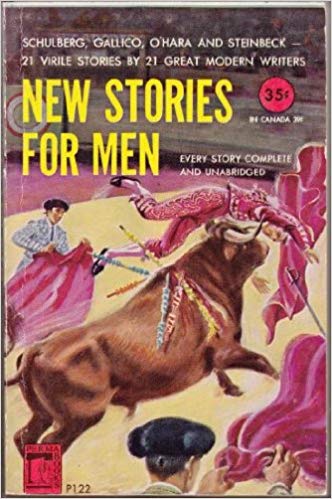Book Review: New Stories for Men edited by Charles Grayson
This 1941 anthology’s title is a trifle misleading, as some of the stories were up to twenty years old at the time of publication. It turns out it’s a sequel to Stories for Men by the same editor a year or two earlier, which became clear about halfway through the book.

The “for men” part is a bit more descriptive, as many of the 21 stories focus on subjects stereotypically interesting to men like sports, violence and crime. And all the stories are written (so far as the editor knew) by men.
“The Road to Recovery” by Budd Schulberg leads off with the tale of an idealistic doctor who is persuaded to move to Hollywood and treat the wealthy hypochondriacs of the film community. He goes Hollywood, which leads to a fall…and perhaps he’ll be able to rise again.
“The Man Who Won the War” by Robert Buckner closes out the volume with a tale of the secret history of World War One. A man met on the train tells the tale of how he won the war; but then, just who is it who lost? It could have happened, but do you believe it?
In between, there’s some notable stories, too.
“The Vigilante” by John Steinbeck picks up just after a lynching, as one of the mob wends his way home. The story is about him trying to process his emotions, and how he feels about this act of violence. There’s use of the N-word. (I should say that there’s quite a bit of period racism, sexism and ableism in many of these stories.) It’s a sparsely written, disturbing tale.
“The Red Game” by T.S. Stribling is about a young bullfighting fan getting a chance to break into the business in Venezuela. I believe this is the first serious story about bullfighting I’ve ever read, and certainly the first that goes into the details of the training. The question of cruelty to the bulls is discussed, and the dangers of the sport are not downplayed. This story also got the cover.
“Pal Joey” by John O’Hara is a slight tale of a piano player who moves to Ohio and gets a break in show business. It’s most notable for being worked into a Broadway play that was very successful.
“You Could Look It Up” by James Thurber I’d read before, and has been anthologized several times. It’s the recollections of an old-time baseball coach and the time his team manager hired a little person (called a “midget” in story) to be a batter. It’s a classic example of the “there ain’t no rule” sports story, though modern readers might not find it nearly so funny.
“The Good Sport” by Sinclair Lewis is the only story in the anthology where the central character is a woman. She’s a very cautious, practical woman who’s been swept off her feet and married an impulsive, ambitious car salesman. Emily is trying to be a “good sport”, not criticizing her husband’s rash decisions or complaining when he fails to consult her before dragging them both into experiences she doesn’t enjoy. But eventually, Emily has to find her own grit and make her own decisions to make the marriage work. Paul means well, but his mouth writes checks his luck can’t cash, and he’s always looking for an even better opportunity.
Each story comes with a brief introduction that talks about the author, and these are interesting too.
Overall, this is a strong collection of stories that many men will find interesting, but some have aged badly due to outdated attitudes. Recommended to men who are willing to put up with those outdated attitudes for the sake of the story.

